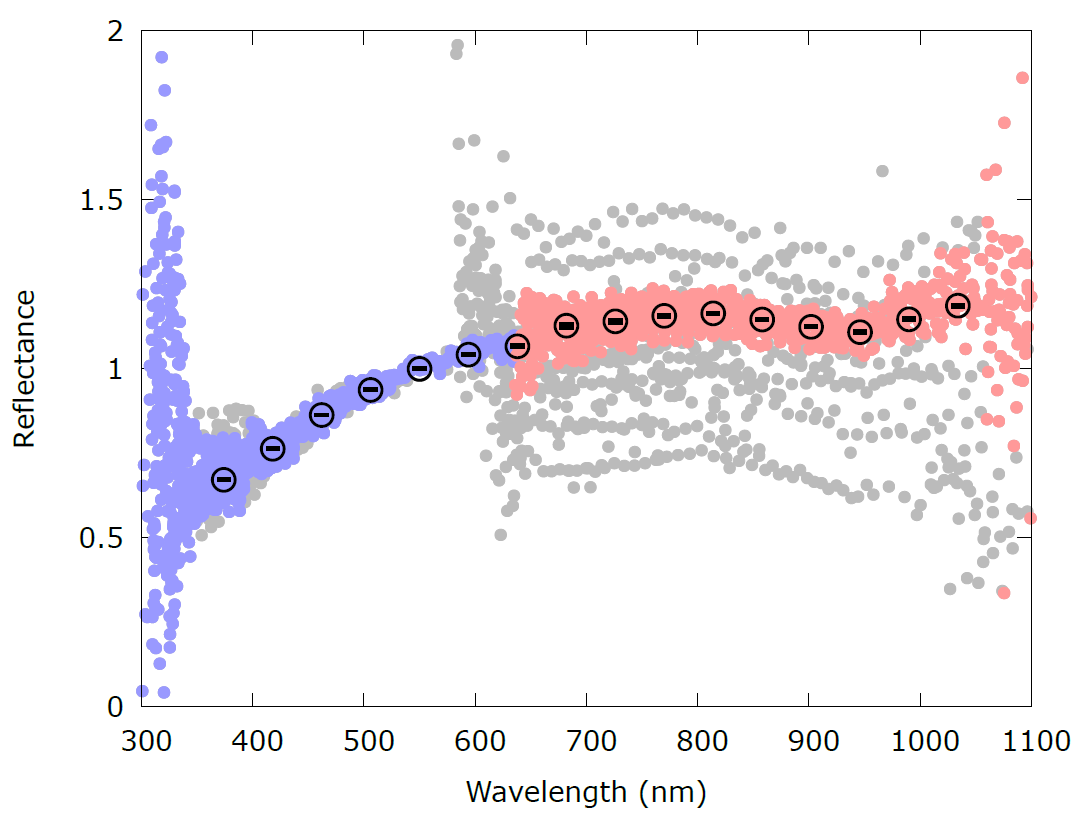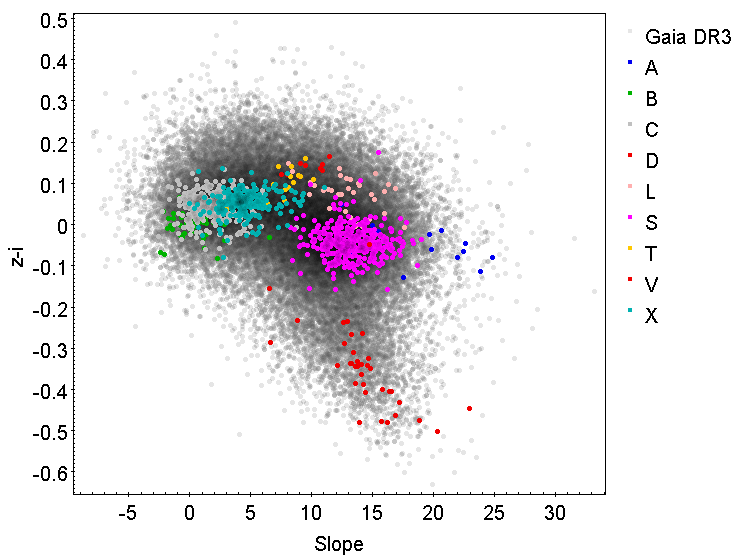Survey of Solar system small bodies reflectance spectra in Gaia Data Release 3
- 1Université Côte d’Azur, Observatoire de la Côte d’Azur, CNRS, Laboratoire Lagrange, Nice , France
- 2Institute of Astronomy, University of Cambridge, Madingley Road, Cambridge CB3 0HA, United Kingdom
- 3Royal Observatory of Belgium, Ringlaan 3, 1180 Brussels, Belgium
- 4INAF - Osservatorio Astrofisico di Torino, via Osservatorio 20, 10025 Pino Torinese (TO), Italy
- 5Leiden Observatory, Leiden University, Niels Bohrweg 2, 2333 CA Leiden, The Netherlands
- 6Department of Physics, University of Helsinki, P.O. Box 64, 00014 Helsinki, Finland
- 7Finnish Geospatial Research Institute FGI, Geodeetinrinne 2, 02430 Masala, Finland
Abstract
The Gaia mission of the European Space Agency (ESA) published its third release (DR3) on June 13, 2022, including for the first time a survey of 60 518 mean reflectance spectra of Solar System objects (SSOs). Each reflectance spectrum was derived from calibrated measurements obtained by the onboard Blue and Red low-resolution spectro-photometers (BP/RP) and consists of sixteen discrete wavelength bands, along with additional information about the data quality for each band.
We will describe the processing of the Gaia spectral data of SSOs and the steps of our internal validation procedures. We present the adopted approach for external validation against SSO reflectance spectra available in the literature, obtained from ground-based and space-borne telescopes, to assess the quality of Gaia SSO reflectance spectra. This work summarizes a more detailed description by Galluccio et al. (2022) [1].
- Introduction
Gaia DR3 contains information for a sample of more than 150,000 SSOs, including astrometry, photometry, osculating elements, and mean reflectance spectra [2]. The selection of these objects is described by Tanga et al. (2022) [2]. Based on the quality of the data and some criteria developed hereafter, DR3 contains 60518 mean reflectance spectra of Near-Earth Asteroids (NEAs), main-belt asteroids, Jupiter Trojans, transneptunian objects (TNOs), and other classes (Table 1) observed at relatively large phase angles (~20°).
Table 1: No. of SSOs with Gaia DR3 spectra for each of the dynamical classes listed on the NASA JPL website. The classes are defined according to the criteria based on the orbital semi-major axis a, the perihelion distance q, and the aphelion distance Q.
|
Dynamical Class |
No. of SSO |
Criterion (values in au) |
|
NEA Aten |
6 |
a < 1.0 & Q > 0.983 |
|
NEA Apollo |
52 |
a > 1.0 & q < 1.017 |
|
NEA Amor |
47 |
1.017 < q < 1.3 |
|
Mars-Crosser |
729 |
1.3 < q < 1.666 |
|
Inner Main Belt |
1 221 |
a < 2.0 & q > 1.666 |
|
Main Belt |
55 976 |
2.0 < a < 3.2 & q > 1.666 |
|
Outer Main Belt |
1 995 |
3.2 < a < 4.6 |
|
Jupiter Trojan |
477 |
4.6 < a < 5.5 |
|
Centaur |
5 |
4.6 < a < 5.5 |
|
TNO |
7 |
a > 30.1 |
|
Other |
2 |
none of the above |
- Production of SSO reflectance spectra
The first step in computing the SSO mean reflectance spectra consisted of a calibration of the BP/RP spectra and removal of all instrumental and astrophysical effects to produce internally calibrated epoch spectra [3]. Each of them is an array of 60 internal flux measurements and corresponding uncertainties, computed for each one of the 60 pixel-long XP (BP/RP). The BP operates in the wavelength range λ between 330 and 680 nm, and RP between 640 and 1050 nm. Next, BP and RP epoch reflectance R(λi)t were determined by dividing the flux ft(λi) of each SSO spectrum at the epoch t by the reference solar analogue spectrum F(λ). The latter has been computed by averaging Gaia DR3 mean spectra of several known solar analogue stars widely used in asteroid ground-based spectroscopy because their spectra closely mimic the one of our Sun. Epoch reflectance was then normalized at λ = 550 nm. To compute the mean reflectance spectrum, we first defined a set of fixed wavelength bands, each one having a width of 44 nm, in the interval from 374 nm to 1034 nm. Inside each wavelength band, we computed a weighted average reflectance using all epoch reflectance present in each bin after applying a sigma-clipping procedure (see Figure 1).

Figure 1: Example of the mean computed reflectance R(λi) (black circles) for the asteroid (61) Danae. The grey points are the R(λi)t corresponding to each epoch reflectance. The R(λi) t values accepted by our filtering method are coloured in blue (BP) and red (RP).
Some filters based on SNR and on quality criteria were finally applied to the sample of computed mean reflectance spectra. Along with the mean reflectance spectra, the Gaia DR3 catalogue also contains for each source a reflectance_spectrum_flag field, indicating the overall quality of the resulting reflectance spectrum.
- Validation
The validation of the Gaia DR3 mean reflectance spectra was obtained by studying and comparing spectral parameters including the spectral slope and the absorption band depth around 900 nm (equivalent to SDSS z-i colour) with those available in the literature, including the SMASSII survey [4] (Figure 2), ground-based observations at large phase angle [5] or space-borne telescope spectra. In general, Gaia DR3 mean reflectance spectra are in good agreement with the literature data. No significant spectral reddening was detected during the validation step.

Figure 2: z colour vs. spectral slope of the asteroids of DR3 (grey dots). Over-plotted with circles of different colours are the same spectral parameters computed by us (see Section 4.2) for the asteroids of SMASSII [4]. The letters C, S, and X represent taxonomic complexes, the other letters spectral classes
- Conclusions
Gaia DR3 includes the largest space-based survey of reflectance spectra of Solar System small bodies observed at visible wavelengths with excellent quality. In the presentation of Delbo et al. (2022) at this conference some preliminary results about the Gaia view of asteroid collisional families will be described.
Acknowledgements
This work has made use of data from the European Space Agency (ESA) mission Gaia (https://www.cosmos.esa.int/gaia), processed by the Gaia Data Processing and Analysis Consortium (DPAC, https://www.cosmos.esa.int/web/gaia/dpac/consortium). Funding for the DPAC has been provided by national institutions, in particular the institutions participating in the Gaia Multilateral Agreement.
References
[1] Gaia collaboration, Galluccio, Delbo et al. 2022 Gaia Data Release 3: Reflectance spectra of Solar System Small Bodies. A&A under review.
[2] Gaia collaboration, Tanga et al. 2022 Gaia Data Release 3: the Solar System survey. A&A under review.
[3] De Angeli et al. 2022, Gaia Data Release 3: Processing and validation of BP/RP low-resolution spectral data A&A under review.
[4] Bus and Binzel. 2002. Icarus 158, 146-177.
[5] Cellino, Bendjoya, Delbo’ et al. 2020. A&A, 642, A80
How to cite: Galluccio, L., Delbo, M., De Angeli, F., Pauwells, T., Tanga, P., Mignard, F., Cellino, A., Brown, A. G. A., Muinonen, K., and Penttilä, A.: Survey of Solar system small bodies reflectance spectra in Gaia Data Release 3, Europlanet Science Congress 2022, Granada, Spain, 18–23 Sep 2022, EPSC2022-357, https://doi.org/10.5194/epsc2022-357, 2022.

